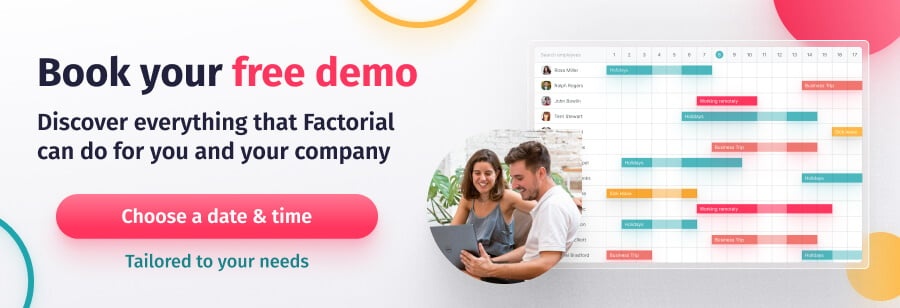When writing a maternity leave letter, you want to inform your employer and secure your leave clearly and professionally.
This article breaks down the must-have elements of your letter, the timing for delivery, and how to structure your leave. We offer real-world samples and actionable steps to ensure you craft a letter that respects your new family needs and workplace commitments.
Check out our other guides on maternity leave here:
What is a Maternity Leave Letter?
A maternity leave letter is a formal document that officially announces the pregnancy of working expectant mothers and their intention to take a leave of absence. This letter sets the stage for maternity leave, establishing clear expectations and securing the mother’s right to statutory maternity pay.

This letter serves dual purposes: informing an employer about a pregnancy and initiating the maternity pay arrangements process. But remember, a maternity leave letter is more than just a notice about your departure – it’s a critical step to protect your rights and ensure a smooth transition during this significant life change.
Crafting Your Maternity Leave Request (From Employer to Employee)
Creating your maternity leave request requires detailed thought and careful attention. It’s not just about informing your employer about your pregnancy; it’s about setting clear expectations for your time away and providing essential information while maintaining a professional and respectful tone.
The Essentials of Your Letter
The initial step in creating your maternity leave letter is incorporating the essential information. This starts with your name and address at the top of the letter, followed by a clear statement of your intention to take maternity leave. You should also specify your due date and the planned start date of your maternity leave, ensuring your employer understands your timeline.
In addition to these basics, your mat leave notice letter should include a copy of your MAT B1 certificate or equivalent documentation and an appointment card for your first appointment. This certificate, provided by your healthcare provider, confirms your pregnancy and the expected due date. It’s necessary for arranging statutory maternity pay.
Lastly, don’t forget to include your preferred method of communication during your leave and, if you prefer, your expected return date.
Timing Your Request
When you submit your maternity leave request is of significant importance. Ideally, you should submit your maternity leave letter about 15 weeks before your due date or as soon as possible after your pregnancy is confirmed. This allows your employer sufficient time to prepare for your upcoming absence.
Early notification not only helps your employer plan, but it also safeguards your rights. By providing further written details about your pregnancy, the expected week of childbirth, and your desired start date for maternity leave, you’re taking the necessary steps to ensure a smooth transition into this new chapter of your life, including attending antenatal appointments.
Addressing Your Employer Properly
How you address your employer can set the tone for your maternity leave letter. Even if you have a close relationship with your employer or work in a small company, it’s essential to maintain a professional and respectful tone in your letter. A formal salutation, such as ‘Dear [Employer’s Name]’, sets the right tone for your request.
This formal mode of address shows respect and helps maintain clarity and professionalism in your letter. It’s a crucial aspect of your maternity leave request to ensure your message is taken seriously and your rights are respected.
Structuring the Leave Plan
A detailed maternity leave plan ensures a smooth transition during your absence. This plan, which should be divided into pre-, during, and after-leave sections, outlines expectations and responsibilities, making it easier for all parties to manage this period effectively.
Preparing Colleagues for Your Absence
Preparing your colleagues for your absence is vital to your maternity leave plan. This can be achieved by creating handover documentation for each project and responsibility you’re handling. These documents serve as a guide for your colleagues, helping them understand and manage yourwork during your absence.

To ensure a seamless transition, schedule handover discussions and provide all relevant contact information for inquiries during your maternity leave. Compiling these notes systematically over time is recommended, rather than rushing them in your final week. This thoughtful preparation not only eases the transition for your colleagues but also gives you peace of mind as you approach your maternity leave.
Keeping in Touch Days (KIT)
Another integral component of your maternity leave plan is Keeping in Touch (KIT) days. These are up to 10 workdays that you can use to stay connected with your workplace during your maternity leave. KIT days can support your cover, maintain workplace relationships, and ease your reintegration upon your return.
Your maternity leave plan can include a schedule for these KIT days, outlining when and how you’ll be in touch. This can be organised through a discussion with your manager or the relevant point of contact at your workplace. Remember, you’re entitled to payment for any work performed on these days, offering you financial compensation during your leave.
Maternity Leave Letter Example (Employee to Employer)
To contextualise all this information, we’ll examine some professional samples of maternity leave letters. These writing samples can be adapted to various workplace environments and job roles, providing a practical guide to crafting your letter.
Mat Leave Letter Sample for Standard Office Settings
A standard maternity leave letter should adhere to a clear structure in an office setting. It should start with a formal notification of your pregnancy, followed by the expected week of childbirth and your proposed start date for maternity leave.
Although a standard letter is a good starting point, each situation’s uniqueness should be remembered. A maternity leave letter should be personalised to cater to your specific circumstances, including your workplace environment and job role.
Remember, this letter serves as an official document. All relevant dates, including your baby’s due date, are essential for confirmation and full disclosure. Clear, straightforward communication helps your employer plan for your absence and protect your rights.
Dear [Supervisor’s Name],
I am writing to formally request maternity leave in accordance with the company’s policies. As of [Expected Start Date], I anticipate beginning my maternity leave, with a planned return on or around [Expected Return Date].
I have thoroughly reviewed the company’s maternity leave policy and would like to utilise the [number of weeks] weeks of paid maternity leave available to me. I understand that this period will begin on my expected start date.
During my absence, I am committed to ensuring a smooth transition of my responsibilities. I am in the process of documenting my current projects and tasks, and I am more than willing to train a temporary replacement or provide guidance to a colleague who will be covering for me.
I am aware of the importance of maintaining open communication during my leave, and I will make myself available via email for any urgent matters that may arise. Additionally, I am confident in the capabilities of my colleagues and am sure that the team will continue to excel in my absence.
I would appreciate it if we could schedule a meeting to discuss the transition plan and any additional details you may require. I am committed to ensuring a seamless handover and returning to work fully prepared.
Thank you for your understanding and support during this exciting yet challenging time. I look forward to returning to the team and resuming my responsibilities on [Expected Return Date].
Sincerely,
[Your Name]
Maternity Leave Letter From Employer
How about the employer’s role in this process? After receiving a maternity leave request, the employer must respond with a confirmation letter acknowledging the request and providing critical information about the leave.
Confirmation Letter Essentials
In the maternity leave process, the employer’s confirmation letter holds significant importance. This letter should acknowledge the receipt of the maternity leave request, reference the employee’s original letter, and outline the statutory leave entitlement of 52 weeks.
In addition to acknowledging the request, the confirmation letter should provide the following details:
- Approved start and end dates of the leave
- Employee’s entitlement to statutory or enhanced maternity pay
- Expected return-to-work date
- Notice period required for any changes to the start or return dates of the leave
Handling Changes and Early Starts
Just like life, maternity leave also holds its fair share of surprises. Employers must be prepared to handle changes in leave dates or early starts due to circumstances like premature births or pregnancy-related illness. In such cases, employers should adjust the maternity leave plan and communicate any changes in a follow-up letter.
In the event of an early birth, employers must confirm the new end date for maternity leave upon receiving the birth certificate or a document signed by a doctor or midwife. If an employee wishes to change their maternity leave’s start or return date, they must provide the required notice.
Implementing Maternity Leave Best Practices
Whether you’re an expectant mother or an employer, adopting maternity leave best practices benefits all involved parties. A positive approach towards maternity leave can contribute to a better work environment, enhance the company image, and ensure a smooth transition during this period.
For Expectant Mothers
Clear communication is essential for expectant mothers. Your maternity leave letter should indicate your understanding of your entitlements, such as the duration of maternity leave you plan to take. This clarity helps your employer manage during your absence and ensures your rights are protected.
Along with clear communication, cooperation with your employer is crucial. Be proactive in completing any required forms or information before your leave starts. This cooperative approach helps your employer and gives you peace of mind as you prepare for your maternity leave.
For Employers
Employers should prioritise having a clear maternity policy. This policy should align with statutory maternity leave and pay, ensuring employees know their rights and responsibilities. Understanding different entitlement rules for specific employment types is also crucial, as it helps you manage your team effectively.
Employers must also provide a safe working environment for pregnant employees. To ensure this, follow these best practices:
- Conduct and review risk assessments
- Discuss any needed work adjustments
- Use HR software or advisory services to streamline maternity leave management and maintain clear communication
By implementing these best practices, employers can foster a supportive environment that respects expectant mothers’ rights and prevents pregnancy discrimination.
Frequently Asked Questions
What should be included in my maternity leave letter?
Include your name, address, due date, leave start date, contact information, and a copy of your MAT B1 certificate in your maternity leave letter. This will ensure all necessary information is provided.
When should I submit my maternity leave letter?
You should submit your maternity leave letter about 15 weeks before your due date or as soon as possible after your pregnancy is confirmed. Aim to give your employer ample notice to plan for your absence.
How can I prepare my colleagues for my absence?
Prepare your colleagues by creating handover documentation for each project and responsibility, scheduling handover discussions, and providing relevant contact information. This will ensure a smooth transition during your absence.
What should be included in the employer’s confirmation letter?
In the employer’s confirmation letter, you should acknowledge the receipt of the maternity leave request, reference the original letter, confirm the start and end dates, and outline the statutory leave entitlement. This ensures clarity and formal documentation of the leave arrangement.
What are some best practices for implementing maternity leave?
When implementing maternity leave, it is important to communicate, cooperate with employers, establish a clear maternity policy, understand entitlement rules, and provide a safe working environment for expecting mothers. These are essential best practices to ensure a smooth maternity leave process.


